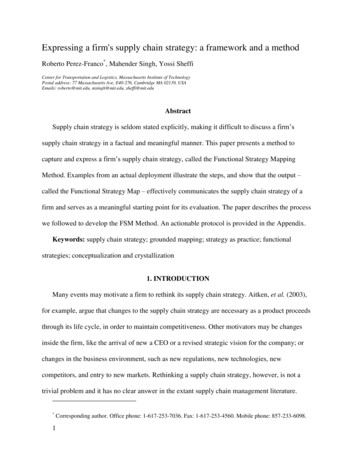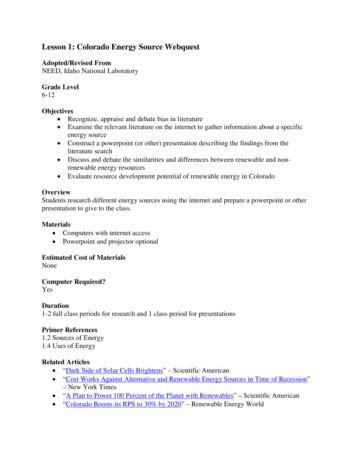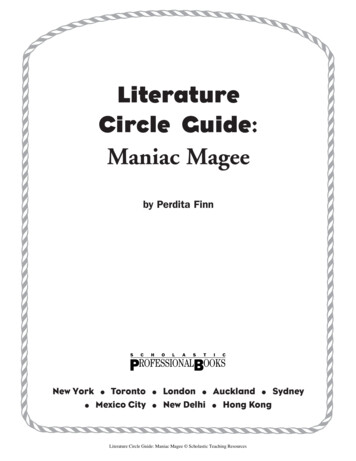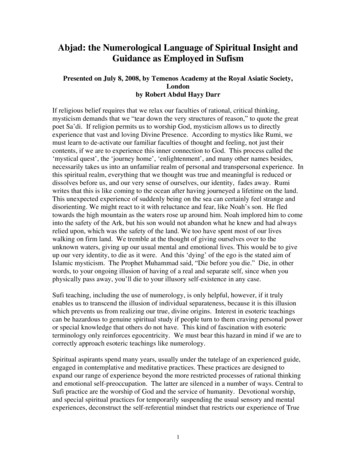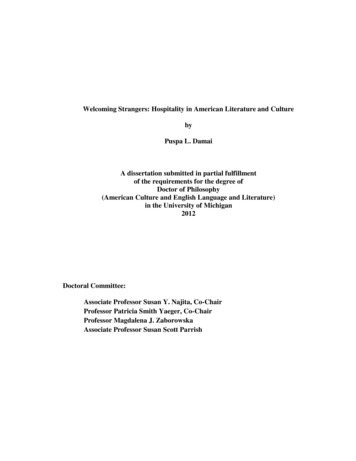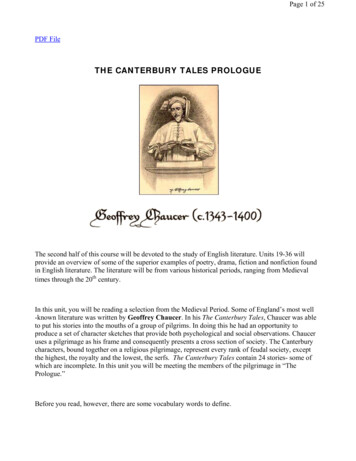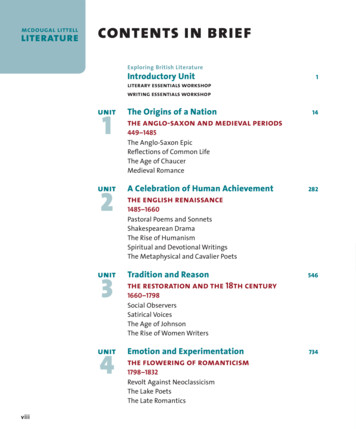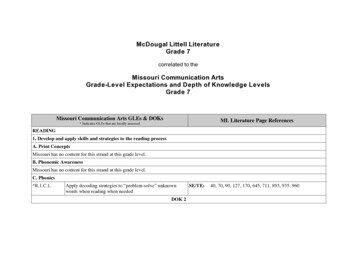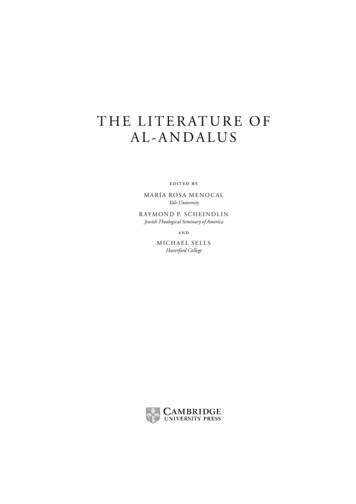
Transcription
T H E L I T E R AT U R E O FAL-ANDALUS M A R Í A RO S A M E N O C A LYale UniversityR AY M O N D P. S C H E I N D L I NJewish Theological Seminary of America MICHAEL SELLSHaverford College
The Pitt Building, Trumpington Street, Cambridge, United Kingdom The Edinburgh Building, Cambridge , UK http://www.cup.cam.ac.uk West th Street, New York, – , USA http://www.cup.org Stamford Road, Oakleigh, Melbourne , AustraliaRuiz de Alarcón , Madrid, Spain Cambridge University Press This book is in copyright. Subject to statutory exceptionand to the provisions of relevant collective licensing agreements,no reproduction of any part may take place withoutthe written permission of Cambridge University Press.First published Printed in the United Kingdom at the University Press, CambridgeTypeface / Adobe GaramondSystem QuarkXPress [ ]A catalogue record for this book is available from the British Library
CONTENTSList of illustrationsNote on transliterationviiiix Visions of al-Andalusby M R M , Yale University Madı̄nat al-Zahrā and the Umayyad palaceby D. F. R , Cornell University Languageby C L -M , Indiana University Musicby D R , University of California at Santa Barbara Spacesby J D. D , School of Architecture, City College, City University of New York Knowledgeby P H , American University of Beirut Loveby M S , Haverford College The Great Mosque of Córdobaby D. F. R , Cornell University The muwashshahby T R , Tel Aviv Universityv
vi The maqamaby R D , Tel Aviv University The qasidaby B G , Yale University The Aljafería in Saragossa and Taifa spacesby C R , Institute for Advanced Study, Princeton Ibn H· azmby E O , McGill University Moses Ibn Ezra by R P. S , Jewish Theological Seminary of America Judah Haleviby R B , Cornell University Petrus Alfonsiby L M A , Bard College Ibn Quzmānby A B , York University Ibn Zaydūnby D J. S , Emory University Ibn T·ufaylby L G , Vanderbilt University Ibn Arabı̄by A K , University of Michigan Ramon Llullby G B. S , Louisiana State University Ibn al-Khat·ı̄bby A K , University of Michigan The dual heritage in Sicilian monumentsby D. F. R , Cornell University Poetries of the Norman courtsby K M , Stanford University
vii Ibn H· amdı̄s and the poetry of nostalgiaby W G , Harvard University Michael Scot and the translatorsby T E. B , University of Tennessee Mudejar Teruel and Spanish identityby D. F. R , Cornell University The Mozarabsby H. D. M , Yale University, and H E. K , University of British Columbia The Arabized Jewsby R B , Cornell University The Sephardimby S G. A , University of California at Davis The Moriscosby L L -B , University of Puerto Rico - , The Nūniyya (poem in N) of Ibn Zaydūn Index
I L L U S T R AT I O N S Madı̄nat al-Zahrā , view into the Salón Rico. Courtesy ofJerrilynn D. Dodds. San Miguel de Escalada, interior. Courtesy of Jerrilynn D. Dodds. The Great Mosque of Córdoba, prayer hall. Courtesy of JerrilynnD. Dodds. Illustration from the Morgan Beatus. Courtesy of The PierpontMorgan Library, New York. MS m. , f v. Santiago de Compostela with temporary facade. Courtesy ofJerrilynn D. Dodds. The Great Mosque of Córdoba, maqs·ūra of al-H·akam II.Courtesy of Jerrilynn D. Dodds. Aljafería, Saragossa, intersecting arches in courtyard. Courtesy ofCynthia Robinson. Monreale Cathedral, exterior of apse. Courtesy of D. F. Ruggles. Santa María Mediavilla. Courtesy of D. F. Ruggles. Tower of San Martín. Courtesy of D. F. Ruggles. viii
CHAPTER 1VISIONS OF AL-ANDALUSMaría Rosa Menocal Come, spend a night in the country with me,my friend (you whom the stars abovewould gladly call their friend),for winter’s finally over. Listento the chatter of the doves and swallows!We’ll lounge beneath the pomegranates,palm trees, apple trees,under every lovely, leafy thing,and walk among the vines,enjoy the splendid faces we will see,in a lofty palace built of noble stones.Resting solidly on thick foundations,its walls like towers fortified,set upon a flat place, plains all around itsplendid to look at from within its courts.Chambers constructed, adorned with carvings,open-work and closed-work,paving of alabaster, paving of marble,gates so many that I can’t even count them!Chamber doors paneled with ivory like palace doors,reddened with panels of cedar, like the Temple.Wide windows over them,and within those windows, the sun and moon and stars!It has a dome, too, like Solomon’s palanquin,suspended like a jewel-room,turning, changing,pearl-colored; crystal and marblein day-time; but in the evening seemingjust like the night sky, all set with stars.It cheers the heart of the poor and the weary;perishing, bitter men forget their want.I saw it once and I forgot my troubles,my heart took comfort from distress,
my body seemed to fly for joy,as if on wings of eagles.There was a basin brimming, like Solomon’s basin,but not on the backs of bulls like his –lions stood around its edgewith wells in their innards, and mouths gushing water;they made you think of whelps that roar for prey;for they had wells inside them, wells that emittedwater in streams through their mouths like rivers.Then there were canals with does planted by them,does that were hollow, pouring water,sprinkling the plants planted in the garden-beds,casting pure water upon them,watering the myrtle-garden,treetops fresh and sprinkling,and everything was fragrant as spices,everything as if it were perfumed with myrrh.Birds were singing in the boughs,peering through the palm-fronds,and there were fresh and lovely blossoms –rose, narcissus, saffron –each one boasting that he was the best,(though we thought every one was beautiful).The narcissuses said, “We are so whitewe rule the sun and moon and stars!”The doves complained at such talk and said,“No, we are the princesses here!Just see our neck-rings,with which we charm the hearts of men,dearer far than pearls.”The bucks rose up against the girlsand darkened their splendor with their own,boasting that they were the best of all,because they are like young rams.But when the sun rose over them,I cried out, “Halt! Do not cross the boundaries!”(from Ibn Gabirol, “The Palace and the Garden,”trans. Raymond P. Scheindlin)As you stand in the astonishing gardens of the Generalife, there seem to be anunlimited number of vistas before you. First there are the layered views thattake in every fine detail of the gardens themselves: the terraces and the courtyards, water visible and audible everywhere. At many turns you come uponthe panoramas that are the dramatic views from the palaces themselves: thesnow-capped mountains, the vivid city below. And occasionally, in crucialplaces scattered throughout this complex, you necessarily look out at the out-
- croppings of the great palaces, and understand immediately that while theGeneralife may indeed have been the most splendid of summer retreats, theother great service it provided was to let you look at the Alhambra itself, fromthat vantage point half-hidden, on the other side of a ravine.These inward and outward visions, all from this edenic promontory,capture all sorts of views of this pinnacle of the culture of al-Andalus. Andjust beyond the gardens what awaits the visitor is the Alhambra itself, thatoften breathtaking palatine city of the Nasrid kingdom of Granada, the locus,since Washington Irving, of the romantic Western vision of “Moorish Spain,”as well as a powerfully evocative emblem, among Muslims and Arabs, of aprecious moment of cultural dominion, subsequently lost. The complexity ofthe problem of vision was understood in crystalline fashion by the builders ofthe Alhambra, who dotted palaces and gardens alike with “miradores,” as thecarefully chosen and laid out lookout points are called, from the Spanishmirar, “to look.” And those half-views of the Alhambra from the retreat of theGeneralife can certainly trigger a version of that emotionally charged reaction, that blend of exhilaration and sadness in the student of al-Andalus, theobject of this volume.The story of the Alhambra, told in the fullness of its complexity, is a mazeof superimposed memories that is a fitting emblem for the powerfully paradoxical and often unexpected cultural history of al-Andalus as a whole. Littleis known about the original fortifications on the hill, although references to a“Red Castle” appear from as early as the end of the ninth century. It is notuntil the middle of the eleventh century that significant palaces and gardensare first built on the citadel: the first building on the site was begun by SamuelIbn Nagrila (Samuel the Nagid), the powerful Jewish vizier of Granada,whose family had fled from Córdoba to Granada at the time of the overthrowof the Umayyads, in . The construction was subsequently continued andelaborated by the Nagid’s son, Joseph, and whereas the Nagid apparentlyrebuilt the fortifications of an original castle to protect the adjacent Jewishneighborhood, his son Joseph built on a more grandiose scale, perhapsworking principally on elaborate gardens.1 The layers of memory and exileare thick here, from the outset: the first real traces of the monument we see inGranada today were sketched out by members of an elite Jewish communityin a common exile from the much-lamented Córdoba of the caliphate, andthe sacked palaces of the Umayyads. And despite the fact that it is merelywishful thinking to see in Ibn Gabirol’s poem – quoted above – a historicaldescription of the unique fountain in the Court of the Lions, the intimatelyshared aesthetics of Hebrew and Arabic poetry, not just in this poem butthroughout Andalusian letters, reveals many shared visions, among them thatof Solomon as quasi-magical prince par excellence.2
If these foundational details are largely not remembered it is becausethe attention of all guidebooks – and in this category one can certainlyinclude most general historical presentations – is per force, and with verygood reason, turned to the Granada of the Nasrids, which between and was the last Muslim city-state of the peninsula. As this last outpost ofwhat had been a brilliant civilization, during those last years of Islamicdominion, the independent kingdom of Granada achieved the cultural andartistic heights manifest in the unrivaled Alhambra. But there is also an illremembered epilogue that, like the prelude, that story of the Ibn Nagrilafamily’s first cultivation of a palatine complex where the ruined Red Castlehad been, is hard to explain smoothly. And yet, without this long postlude wemight hardly be able to see this memory palace, let alone name it the pinnacleof Islamic culture in Spain: in , immediately upon taking control of thecity from the last of the Nasrids (poor Boabdil, whose infamous “last sigh” isremembered as a sign of his pathetic inability to hold on to this preciousplace), Ferdinand and Isabella proclaimed the Alhambra a casa real, or royalresidence, which it in fact remained until . And whether this act of appropriation was simply to flaunt this trophy of the Christian conquest over Islam(as is normally maintained) or for more complex reasons as well, the undeniable effect of the royal protection and patronage was to keep the Alhambrarelatively well preserved over the centuries. Paradoxically, and despite themuch reviled Renaissance palace of Charles V that sits uncomfortably atthe entrance of the Alhambra complex (which itself may be a part of theparadox), its absorption into the royal treasuries of the Catholic monarchsplayed a crucial role in making it a better preserved medieval palace than anyother in the Islamic world.But what might be paradoxes and juxtapositions in other historical or cultural circumstances are very often the bread and butter of al-Andalus. Thus,both the beginning and the end of the story of this Red Castle are powerfulattestations to the unusually strong and complex relationships among thereligions of the children of Abraham in this land. The role played by theJewish community in the early chapter of the Alhambra speaks eloquentvolumes: the telling intimacy of the Jews of Granada sharing power as well asthat yearning for a lost homeland, where the layer of Córdoba and a sackedMadı̄nat al-Zahrā would have mingled with others. And at the end, we seethat Catholic preservation of the Alhambra after the end of the Reconquest,and throughout the period of the Inquisition, while countless Arabic manuscripts were destroyed (most notoriously in Granada), and while the descendants of the Muslims who had built the Alhambra were being forciblyconverted, persecuted, and eventually expelled. The adoption of the palacesand gardens, in such a context, is perhaps a more complex phenomenon than
- is normally acknowledged: the reflection that the Islamic arts were immoderately admired, quite independently of religious and political ideologies, anattitude that will account for the wide range of surprising “mixed” forms socharacteristic of al-Andalus, from the muwashshahs in literature to theMudejar
22 Michael Scot and the translators 404 by Thomas E. Burman, University of Tennessee Mudejar Teruel and Spanish identity 413 by D. F. Ruggles, Cornell University part v marriages and exiles 23 The Mozarabs 417 by H. D. Miller, Yale University, and Hanna E. Kassis, University of British Columbia 24 The Arabized Jews 435 by Ross Brann, Cornell .


